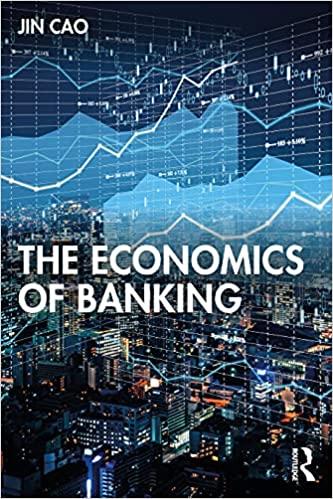Consider an economy that is populated by a bank, consumers whose population is normalized to be 1,
Question:
Consider an economy that is populated by a bank, consumers whose population is normalized to be 1, and a regulator. Each consumer is born in \(t=0\) with 1 unit of endowment, and they can invest in the bank via being either shareholders or depositors of the bank. Consumers are risk neutral: if they become depositors, they require a gross expected return equal to 1; if they become shareholders, they require a gross expected return strictly higher than 1.The economy lasts for 3 periods, \(t=0,1,2\) :
- In \(t=0\), the bank raises 1 unit of funding which consists of \(k\) equity that is collected from shareholders and \(1-k\) deposits that are collected from depositors, then it issues 1 unit of loans to firms. The equity ratio \(k\) is a constant number that is required by the regulator. Each of the firms invests in ex ante the same projects that will return in \(t=2\). The projects' return is stochastic and unknown in this period. Firms have no initial wealth so that they totally rely on bank funding, and the bank is able to extract all yields from the projects;
- In \(t=1\), there is public information about each project's return in the future: (1) a share \(1-q\) of the projects will be good and return \(R>1\) in \(t=2\) with certainty, and (2) a share \(q\) of the projects will be bad, so that they will only return \(R\) in \(t=2\) with probability \(p\), or 0 otherwise. The bank has two options with bad projects:
- Liquidating the bad projects, which generates a liquidation value \(0<\delta<1\) for each liquidated project.
Then the bank can use the proceeds that are collected from liquidation to invest in good projects that return \(R\) each in \(t=2\). Assume that, when choosing liquidation, the expected gross return of the bank is strictly higher than 1;
- Doing nothing and keeping the bad projects ("rollover"). In addition, assume that rollover is socially inferior such that the expected return from rolling over a bad project is lower than liquidating it, i.e., \(p<\delta\).
- In \(t=2\), the bank collects return from all projects and repays the depositors. The bank's shareholders claim the residual.
The regulator has a recapitalization technology: if needed in \(t=1\), she can take over depositors with a guarantee on their repayment in \(t=2\), and become shareholder of the bank herself. That is, using this technology, she can convert one unit of deposit to one unit of equity.
(a) Suppose that even if the bank chooses to roll over the bad projects in \(t=1\), the bank is still solvent, but the expected gross return of the bank is strictly lower than 1. Assume that the bank is only insolvent if it chooses to roll over the bad projects in \(t=1\), and the projects fail in \(t=2\). Characterize the condition on which the bank, representing the interests of shareholders, chooses liquidation instead of rollover. What is the lowest capital ratio \(k\) that the regulator needs to fulfill this condition? How is \(\underline{k}\) affected by \(q\) and \(\delta\) ?
(b) Suppose that the economy starts in \(t=0\) with a \(k\) that just fulfills the condition characterized in question (a), or, \(k\) is higher but indefinitely close to \(\underline{k}, k \rightarrow \underline{k}^{+}\). In \(t=1\), assume that the economy is hit by an unexpected shock that the share of bad projects is \(q+\epsilon, \epsilon>0\). Show that the bank only chooses liquidation instead of rollover if the regulator recapitalizes the bank and increases the bank's equity ratio. Compute the minimum amount of new equity that the regulator needs to inject.
Step by Step Answer:






